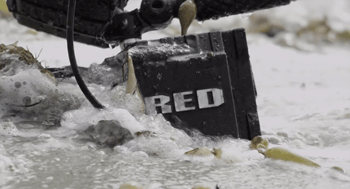Emota: Deploying CatDV Pegasus within a RED Epic Native Workflow
 Emota is a San Diego based video agency that describes themselves as, “Digital storytellers, entertaining the customers of the world’s best brands.” When they were awarded Petco’s video agency of record, they knew they would need a solid asset management system to keep track of the sizable amount of media assets they would be generating in the process.
Emota is a San Diego based video agency that describes themselves as, “Digital storytellers, entertaining the customers of the world’s best brands.” When they were awarded Petco’s video agency of record, they knew they would need a solid asset management system to keep track of the sizable amount of media assets they would be generating in the process.
They could see how their creative team and their clients would benefit from the efficiencies that asset management provides. And like most users, they wanted a solution that would be easy to use and allow them to quickly locate specific files and stay creatively focused on developing their content. Seeking to find the right system to fit their needs, Chris Karcher, Emota’s Chief Creative Officer connected with ProMAX to find the best DAM solution.
 Emota had already implemented a very forward-thinking workflow: editing their native RED Epic files within Adobe Premiere in full resolution, and moving to DaVinci for their color correction, never leaving the R3D format.
Emota had already implemented a very forward-thinking workflow: editing their native RED Epic files within Adobe Premiere in full resolution, and moving to DaVinci for their color correction, never leaving the R3D format.
This contrasts with traditional RED workflows which have been based around creating a mezzanine file for the editorial process and then linking back to the native R3D files for color grading and final output. Adobe Premiere has changed this by allowing direct ingest and editing of the R3D media, thereby removing the extra transcode and media management step. While this saves a great deal of time in editing, most asset management systems will not import or manage RED media directly and so the removal of these mezzanine files presents a new challenge for the DAM industry.
 The digital asset management system that Emota had chosen, Squarebox System’s CatDV Pro, had followed the original RED NLE workflow in the past. This was fine for managing RED ONE footage. But the way RED Epic files are written to RED mags, coupled with the capabilities of Premiere added a new layer of complexity. Emota wanted to implement an asset management system leveraging the power and flexibility of CatDV, but only if they could do it without compromising their streamlined editorial process.
The digital asset management system that Emota had chosen, Squarebox System’s CatDV Pro, had followed the original RED NLE workflow in the past. This was fine for managing RED ONE footage. But the way RED Epic files are written to RED mags, coupled with the capabilities of Premiere added a new layer of complexity. Emota wanted to implement an asset management system leveraging the power and flexibility of CatDV, but only if they could do it without compromising their streamlined editorial process.
To meet Emota’s unique needs ProMAX partner, North Shore Automation (NSA) was brought into the mix to provide custom development beyond what CatDV would offers “out of the box”. NSA develops customized software solutions for unique and challenging media workflows and has a long history working with CatDV. NSA engineers reached out to Squarebox systems to discuss their Pegasus product which had been recently announced but was still unreleased at the time.
 Squarebox viewed this new RED format as an opportunity to expand CatDV’s capabilities. Although most of their user base was still working with a Mezzanine file, Squarebox took on development of a next generation RED Epic workflow compatible with the capabilities of Adobe Premiere and other NLE’s that natively edit the media. CatDV Pegasus is currently the only asset management product on the market to correctly manage RED EPIC media; allowing users to import, catalog and tag RED footage, adding their own metadata alongside the camera’s own. Squarebox gave NSA a pre- release version of Pegasus for testing, and the product proved capable of handling Emota’s RED footage with ease. Once the system was installed and users were trained, Emota was able to use CatDV Pegasus to manage RED EPIC assets as easily as less complex media formats.
Squarebox viewed this new RED format as an opportunity to expand CatDV’s capabilities. Although most of their user base was still working with a Mezzanine file, Squarebox took on development of a next generation RED Epic workflow compatible with the capabilities of Adobe Premiere and other NLE’s that natively edit the media. CatDV Pegasus is currently the only asset management product on the market to correctly manage RED EPIC media; allowing users to import, catalog and tag RED footage, adding their own metadata alongside the camera’s own. Squarebox gave NSA a pre- release version of Pegasus for testing, and the product proved capable of handling Emota’s RED footage with ease. Once the system was installed and users were trained, Emota was able to use CatDV Pegasus to manage RED EPIC assets as easily as less complex media formats.
With the ingest, cataloging and tagging of the files addressed, creation of low res proxy files was the next order of business. Since only RED’s own software could create a quicktime proxy of R3D files through a scripted action, North Shore Automation set out to script an automation that would allow CatDV Worker Node to use REDLINE to create the necessary proxy file format.
 To accomplish this, NSA adapted a plugin that they had originally written to allow the powerful render management system, Deadline® to manage a cluster of less exotic proxy creation nodes. This plugin not only allows CatDV to drive the process but enables two-way communication of job status from transcode nodes back to the CatDV Server.
To accomplish this, NSA adapted a plugin that they had originally written to allow the powerful render management system, Deadline® to manage a cluster of less exotic proxy creation nodes. This plugin not only allows CatDV to drive the process but enables two-way communication of job status from transcode nodes back to the CatDV Server.
The addition of the new RED compatibility allows the Worker Node to utilize Emota’s existing RED ROCKET hardware, handing the proxy transcoding jobs off to the Deadline queue so that in the future, multiple render systems can be added and controlled to match any production pace. This final piece gave Emota a complete, end to end solution for managing their assets without compromising the speed and efficiency of their superior editorial workflow.
The collaboration between ProMAX, Squarebox Systems and North Shore Automation for Emota, illustrates how delivering a modern workflow can require a wide range of skills and resources. The constant innovation in camera technology and editorial software makes video specific expertise imperative to helping customers meet the demanding requirements of post production processes. The final result is a testament to Manufacturer, Integrator, Software Developer and Client all working together to establish a cutting edge workflow without compromise.
